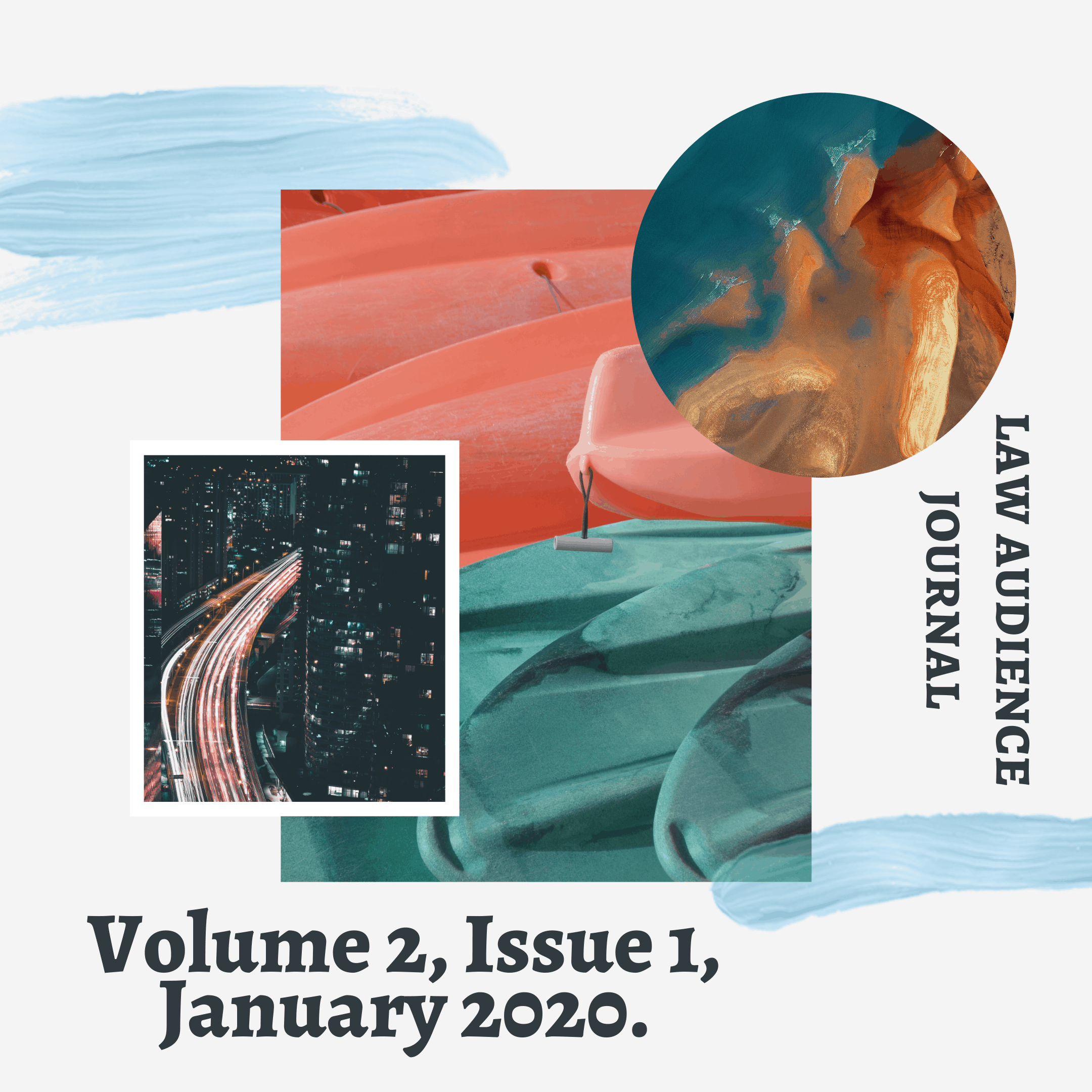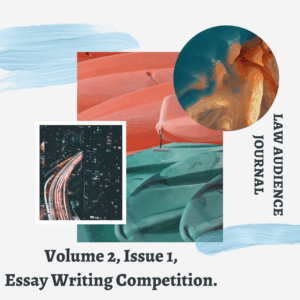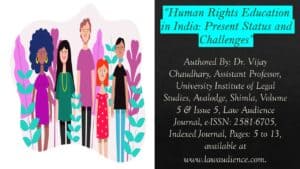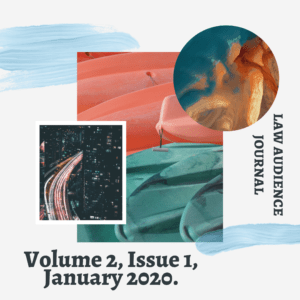Authored By: Mr. Ritik Khatri, B.A.LL.B, National Law University, Odisha.
I. HISTORY:
Protection of Children from Sexual Offences Act (hereinafter POCSO) was passed by the Indian Parliament in the year of 2012 and the amendment bill was tabled in the year of 2011. The need for making a separate law arose due to the incompetence in the present laws. POCSO law deals primarily with the violation of child rights where their sexual dignity is harmed. India has also ratified to the UN convention on Right to Child 1992, which lays basic rights of the children of survival, development of their mental and physical potential and participation in family, cultural and social life.
Child sexual abuse differs largely from adult sexual abuse. The child being a minor in most situations is unable to comprehend that his sexual identity is assaulted. Children often think that the wrongdoings happening with them are normal for every child. A child is not mature enough in cases to understand that his kith and kin are the perpetrators giving him mental trauma and hindering his social growth.
Before the coming of the POCSO Act, offences reported were mostly governed by the Indian Penal Code, 1860. There was not any specific law under which offenders could be prosecuted. In various cases, it was observed that offences committed were not mentioned in the Indian Penal Code and IPC was silent on some specific wrongs. Resulting to which perpetrators were left either unpunished or were not given adequate punishment. Sexual offences against children were broadly covered under the umbrella section of IPC viz. Section 322[1] which deals with causing physical grievous hurt, Section 350[2] defines use of criminal force, in situations where clear definition of crimes committed by offenders was not present these sections were blindly put, although for the stringent punishment perpetrators were booked under Section 354[3] which provides for punishment for assault towards a women which outrages her modesty, Section 375[4] dealing with rape and lastly Section 377[5] which provides for unnatural offences.
These sections though prosecuted offenders but were inadequate in various particular crimes. These laws have problems like no lucid definition of modesty, the laws were not gender-neutral they only considered female victims and in Section 375 the definition of rape included only the traditional peno-vaginal intercourse. With the advancement of time, the laws were still out-dated. Cases were observed in which heinous and brutal ways of committing rape was used for example using objects like the glass bottle and iron rod. This called for new legislation which would meet the need of present and also clause (3) of the article 15 of Constitution of India entitle the State to make special provisions for children and hence a new statute of POCSO Act, 2012 came into existence.
II. MERITS OF POCSO ACT, 2012:
- A comprehensive definition of penetrative sexual assault[6] which includes punishing a person for penetrating his penis or any object to any extent into the vagina, mouth, urethra or anus of a child or making the child to do the thing.
- The Act includes punishment for the abuse of power[7] too, if any police personnel, armed officer, an officer of security forces in charge or any public servant is found committing penetrative sexual on a child when doing the duty of the state shall be liable for stringent punishment.
- Penetrative sexual assault is made exhaustive as it covers every possible way of its commission from by a relative who is in a position of trust using undue influence on the child to by a staff of an educational institution.
- The Act widens the scope of sexual harassment, adding more value to IPC Section 354[8] by covering objectification of child in any pornographic purposes and also punishing person threatening the child to exhibit any part of his body.
- The Act encompasses the umbrella term media which includes print, electronic, computer or any other technology for preparation, production, offering, transmitting, publishing and distribution of pornographic material.
- The Act also penalises for the storage of pornographic material involving a child.
- The Act provides a lucid and transparent procedure for reporting of offences under Section 19[9] which says that any person having apprehension of an offence likely to be committed can inform it to Special Juvenile Police Unit or the local police. Further, the section eases it for the victim to be aware of the contents recorded as being provided by a translator or an interpreter if the child fails to understand the same.
- The Act obligates the Special Juvenile Police Unit or the local police to intimate the matter to Child Welfare Committee[10] or the Special Court or in its absence to the Court of Session so that the child could be provided with care and protection in the regard.
- The media is also debarred from making anything public which discloses the identity of the victim including his name, address, photograph, family details or any particulars which can be used to outrage the modesty of the victim[11].
- The official procedure is made child-friendly, for example, the obligation of the police officer to record the statement of a child at his residence or at the place of his comfort[12].
- The Act commands that no child should be detained in the police station in the night for any reason[13].
- For the expedite disposal of justice, the Act provides for the establishment of Special Courts[14] in each district. The Act also empowers the Special Court to have jurisdiction in cases dealing with Section 67B[15] of the Information Technology Act, 2000.
- The Act allows the Special Court to take cognizance of any offence by receiving a complaint of facts[16] and also the Special Courts are asked to complete the trial as far as possible within one year of receiving the complaint.
- Section 36(2) makes provision for the child not to see the accused at the time of testifying.
- The Act casts upon the Special Court a duty to try cases in camera and in the presence of confidant of the child.
- Pursuant to Article 39A of Constitution of India and Section 301 of the Code of Criminal Procedure, 1973 the child is entitled to a legal counsel of their choice provided that the guardians are unable to afford the same.
III. THE PROTECTION OF CHILDREN FROM SEXUAL OFFENCES (AMENDMENT) ACT 2019:
The Act was introduced in the Rajya Sabha vide Bill No. XXII of 2019. The POCSO Act is very strong legislation but it asks for more religious implementation. As per National Crime Records Bureau, a total of 34,449, 34,505 and 36,022 cases are registered under Protection of Children from Sexual Offences (POCSO) Act, 2012, related with other section of IPC during 2014, 2015 and 2016 respectively[17].
After 2016 there was a surge in the commission of crimes related to the children; 1,04,976 cases registered under POCSO Act during the year 2014-16[18], which called for an immediate need to make punishment under POCSO Act more stringent so that it acts as deterrence for the perpetrators. India follows the reformative theory of punishment wherein the state believes in remoulding the inmates so that when they leave they become a reformed being and be an asset to society but we cannot deny the power of deterrence. Deterrence lays fear in the society and sensitizes against the repercussions which are the reason stringent punishments are given for the offences of child sex abuse. The Amendment Act mainly contains provisions for increased punishments; it has also empowered Courts to bestow on with capital punishment in rarest of the rare case which is left to the intelligentsia of courts.
The particulars of the amendment Act are as follows:
- The punishment for penetrative sexual assault increased from a minimum of seven years to a minimum of twenty years and may also extend to imprisonment for the remainder of the natural life of that person.
- The amendment Act asks for the fine imposed on the convict to be just and reasonable and must be paid to the victim to meet the medical expenses and rehabilitation of such victim. This was a step which was long due and the legislature is appreciated for bringing such amendment as earlier the victim in most cases didn’t have resources to get back from the mental and physical trauma and get rehabilitated.
- Situations in penetrative sexual assault and in aggravated penetrative sexual assault in the subsection (s) of the particular sections have been changed from “communal or sectarian violence” to “violence or during any natural calamity or in similar situations”. A good number of cases of child sexual abuse are reported in the situations of communal riots or the violence which takes place after the altercation between the religious communities and the children below 16 become prey to the society seeking revenge in them. This addition further broadens the scope by also including natural calamity.
- Administering any drug or hormone or any chemical substance to a child with the intent that such child attains early sexual maturity has also been included in the definition of aggravated sexual assault by adding a subsection (v) in Section 9.
- Amendment Act puts rigorous punishment for using a child for pornographic purposes, earlier the punishment said for a maximum of five times for the first time convict now it amends to a minimum of five years. Earlier for the subsequent commission, the maximum punishment was seven-year now it gets amended to a minimum seven years.
- The Act punishes for storage of pornographic materials containing child for commercial purposes or for the storage or for the negligence in reporting it to designated authority, the accused shall be liable for a fine of ₹ 5000 and an imprisonment which may extend to three years and in subsequent reporting of offences a fine of ₹ 10000 and an imprisonment which shall not be less than five years.
IV. RECOMMENDATIONS:
Statutes are to be amended when time demands to meet with the pace of present. Loopholes are intrinsic of every statute, none is perfect. There is always a space to make amends. Protection of Children from Sexual Offences (Amendment) Act, 2019 is appreciated legislation but also there are some ground nuances which the Act ignored. If the implementation of any Act is not done in the correct way then it does not add value to the legislation. There are certain areas which the Act as expected to acknowledge but it was disregarded. Some of them are as follows:
- According to Section 2(d), a child means any person below the age of eighteen years; this is the biggest loophole in the Act which considers anyone through their biological age, not their mental age. There are cases where a victim has been affected by cerebral-palsy of the biological age of 36 years old and the mental age to be six to eight years old. If a child of such ability is raped then only IPC 375 is the resort and the POCSO Act won’t come into play.
- POCSO Act does not consider adolescents from 16-18 years old of age as consenting adults. The High Court of Madras[19] to clear this ambiguity observed (Obiter Dicta) that the age of a child should be reduced from 18 to 16.
- Section 22 of the POCSO Act provides for the punishment for false complaint but Section 22(2) exempts a child from the imposition of any punishment on lodging a false complaint. If we see the ground reality families just to seek revenge from other use this section and also cases have been reported where families used this section to blackmail other person and extort money. Recommendations on this section should be to not do away with the subsection but to add some punishment in it.
- Section 24 and Section 25 of the Act provides for the procedure for recording statement of the child, if the statement is recorded under Section 164[20] of the Code of Criminal Procedure in the Court of Sessions receiving of statement happens after two to three days of filing of complaint in majority of cases the victim turns hostile as there is no victim protection scheme. This process must be expedited by providing Special Courts to deal with Child Sexual Abuse.
- Section 27 of the Act speaks for the medical examination of a child and subsection (2) says that in the cases where the victim is a girl child, the medical examination is to be conducted by a female doctor only. This section contradicts with the Section 166A[21] of the Indian Penal Code which mandates the government medical officer on duty to examine the rape victim without fail. A conflicting legal position arises when a female doctor is not available. The State must ensure that every government hospital must have at least one female medical officer to deal with cases of such nature.
- POCSO Act pursuant to section 28 provides for Special Courts in each and every district in all the states of India. According to the government 1023, Special Courts must be established in all over India, it’s been roughly eight years since the passing of the Act and only 664 courts[22] established till 30th April, 2019. It is an unsaid thing to get to the final number as soon as possible to do away with a number of cases under the POCSO Act still in the Court.
V. CONCLUSION:
In rural areas victim of parents does not know what their rights are and there is specific legislation named POCSO meeting the special needs of the situations. There is a need to sensitise all stakeholders involved ranging from the victim and the parents to the police officials taking the complaints. Police officials were found reporting cases of POCSO Act under IPC Section 375 which is for rape.
Various awareness drives must be carried out in the economically lower strata of society. The State should understand the role of the mental health of a child, there is no counselling available for the child to recover from the post-traumatic disorder. POCSO Act largely encompassed offences of child sexual abuse. The POCSO Act read with the recent amendments has also to an extent validated the UN Convention on Right of Child. India is a diverse country with different sects, cultures, and beliefs with the largest number of children in the world. Ensuring child rights to every child in India is a difficult task as it has many subtle nuances starting from legislation to execution.
When viewed with the subtlety involved India as a country is at a great space ensuring child rights, although there are also some shortcomings in the POCSO Act, it’s high time the legislature must take these loopholes into consideration and conclusively the POCSO Act and the amendment Act is highly welcomed legislation.
[1] The Indian Penal Code 1860, s 322.
[2] The Indian Penal Code 1860, s 350.
[3] The Indian Penal Code 1860, s 354.
[4] The Indian Penal Code 1860, s 375.
[5] The Indian Penal Code 1860, s 377.
[6] The Protection of Children from Sexual Offences Act 2012, s 3.
[7] The Protection of Children from Sexual Offences Act 2012, s 5(a).
[8] See n 3.
[9] The Protection of Children from Sexual Offences Act 2012, s 19.
[10] The Protection of Children from Sexual Offences Act 2012, s 19(6).
[11] The Protection of Children from Sexual Offences Act 2012, s 20.
[12] The Protection of Children from Sexual Offences Act 2012, s 24(1).
[13] The Protection of Children from Sexual Offences Act 2012, s 24(4).
[14] The Protection of Children from Sexual Offences Act 2012, s 28.
[15] The Information Technology Act 2000, s 67B.
[16] The Protection of Children from Sexual Offences Act 2012, s 33(1).
[17] Press Information Bureau, ‘Ministry of Women and Child Development’ (PIB Delhi, 08 FEB 2018) <https://pib.gov.in/Pressreleaseshare.aspx?PRID=1519943 > accessed 15 Dec 2019.
[18] Crime In India, ‘National Crime Records Board’ (Ministry of Home Affairs Statistics 10 OCT 2019) <http://ncrb.gov.in/StatPublications/CII/CII2017/pdfs/CII2017-Full.pdf> accessed 15 Dec 2019.
[19] Sabari v The Inspector of Police and Ors, (2019).
[20] The Code of Criminal Procedure 1974, s 164.
[21] The Indian Penal Code 1860, s 166A.
[22] Press Information Bureau, ‘Special Court for Juvenile Justice’ (PIB Delhi, 19 JUL 2019) <https://pib.gov.in/Pressreleaseshare.aspx?PRID=1579557> accessed 20 DEC 2019.



